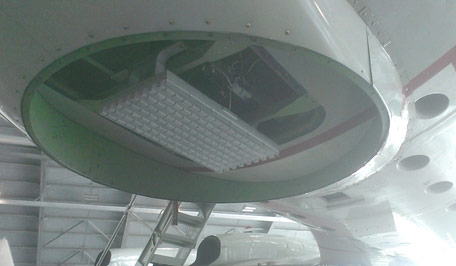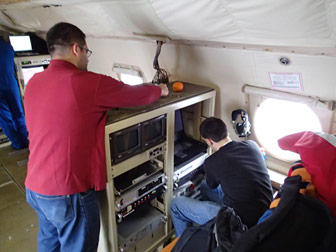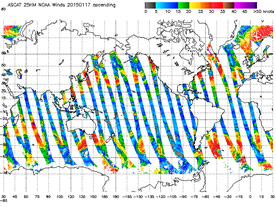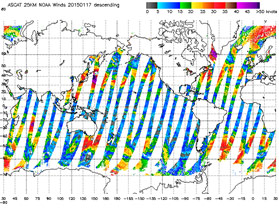- STAR Home
- > News &
Events
- > 20 January 2015 - STAR's Ocean Surface Winds Team Begins Winter Storms Flight Experiment over the North Atlantic
STAR's Ocean Surface Winds Team
Begins Winter Storms Flight Experiment over the North Atlantic

ASCAT Follow-on prototype antenna integrated with the IWRAP instrument on the NOAA P-3 (Kermit)20 January 2015 - The NESDIS Ocean Winds winter flight experiment started on January 12
and will run through February 14. Personnel from STAR and NOAA's Aircraft
Operations Center deployed on the NOAA WP-3D N42RF (Kermit) aircraft to
Halifax, Nova Scotia. Over the next month, flights will be conducted over
the North Atlantic and Labrador Sea. The P-3 carries advanced remote-sensing
equipment including the Imaging Wind and Rain Profiler (IWRAP)
developed and built by the Microwave Remote Sensing Laboratory at the
University of Massachusetts, Amherst. IWRAP is a C-band and Ku-band dual-
polarized (vertical and horizontal polarization) profiling scatterometer
system designed to measure the backscattered signal from precipitation and
the ocean surface.

Suleiman Alsweiss and Joseph Sapp working on the IWRAP instrumentation on the NOAA P-3
There are several objectives for this experiment including validation
of existing on-orbit satellite sensors ASCAT (EUMETSAT) and RapidScat
(NASA), advancing the knowledge of the remote-sensing physics of the ocean
surface, and testing and evaluating new remote-sensing techniques and
instrumentation. Satellite ocean surface vector wind data such as those
provided from the ASCAT and RapidScat instruments provide critical
information utilized by the National Weather Service's Ocean Prediction
Center and National Hurricane Center to support wind and wave forecasting
in the marine environment.
During this winter's experiment, NOAA and the European Space Agency
collaborated to install on the NOAA P-3 a prototype antenna developed for
the ASCAT follow-on scatterometer (SCA) planned for the EUMETSAT Polar
System - Second Generation (EPS-SG). One of the improvements being
considered by ESA and EUMETSAT for the ASCAT follow-on instrument is to
include a cross-polarized receive capability to extend the high wind speed
sensitivity of SCA beyond that of ASCAT. Having the prototype SCA antenna
capable of making these measurements over a broad range of wind conditions
installed on the P-3 will allow us to fully characterize this capability
for the first time and provide invaluable data to support the ongoing SCA
instrument study and development process.
STAR Ocean Surface Wind Team members deployed on this project include:
Paul Chang, Zorana Jelenak, Suleiman Alsweiss, Joseph Sapp and Micah Baker.
ASCAT Ascending and Descending Images from 17 January 2015


|

